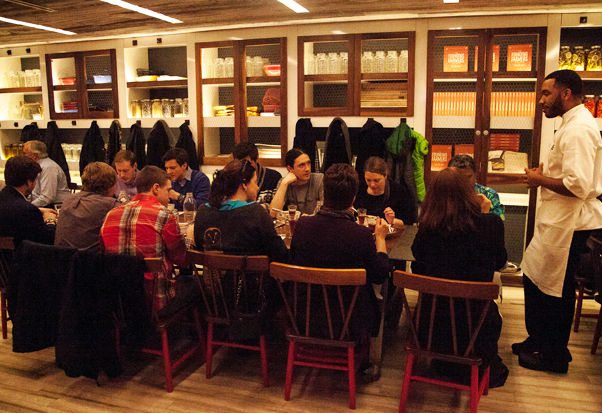In most full-service restaurants, long gone are the days of white tablecloths, ‘bad’ tables near the kitchen or restrooms, and tables spread across oversized dining rooms. Restaurant guests today are embracing the more casual feel to dining, where communal dining has become more than a small trend – it’s often critical for restaurants to maximize seating capacity and flexibility. And what’s not to love?
Interesting behavioral trends amongst guests and diners in public offer some insight and support for the idea that communal-style, familial seating (different parties at one large table) could do well for restaurant owners today. Some thoughts are that guests seemingly want to gather around a table with like-minded people with similar tastes, which can facilitate friendly discussions about the dining experience, atmosphere, food, etc. In the end, don’t we all want to become a part of a bigger community – or at least know what our neighbor might be enjoying at the next table or seat?
That said, does a communal style seating arrangement work for every concept? “Not really,” says VSAG’s Dan Simons. “Community tables offer a mixed bag of appeal and results,” he says, “they work for some concepts and not for others. The unique situation of the brand and the diners usually dictates a positive or negative outcome with a communal table experience.”
In essence, when community tables are wrong for the brand and wrong for the guest, they simply become “large party tables,” which can prove productive only if the restaurant can consistently turn them fully maximized. On the other hand, when a 10-top table is turned as only a six or an eight-top table, the communal table scenario can prove to be a detriment.
So, when it works, it’s fabulous: guests have memorable experiences, they enjoy the buzz and energy of the space, and new relationships that can develop from the camaraderie of communal dining. But, when it doesn’t work, those unproductive tables hit the bottom line and guests leave disappointed (most likely not to return).
The key to success is to understand the idea of the communal table through the eyes of the guest. Gauge guests’ dining behavior and trust that your brand and your dining environment will entice and excite diners and fit the communal style-dining bill. For example, communal dining doesn’t fit within the confines of an upscale, white tablecloth establishment where guests have traditionally viewed space as a luxury.
If you are interested in communal-style tables but are afraid of going all in at first, offer an array of larger tables for guests to socialize around along with high tops and/or more intimate, smaller tables for those that desire some privacy.
A happy medium mixed with moderation might just be your brand’s recipe for communal success.

photo courtesy of Farmers Fishers Bakers
